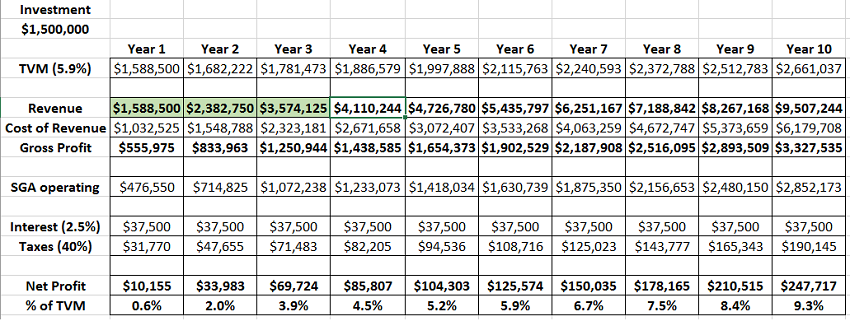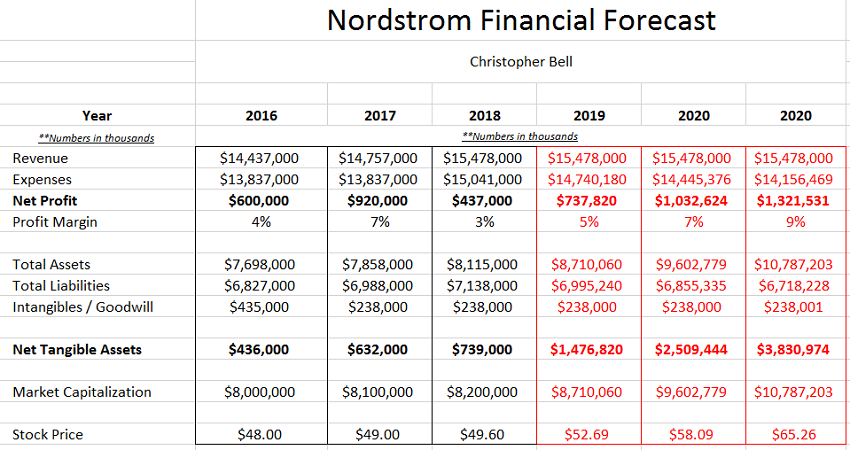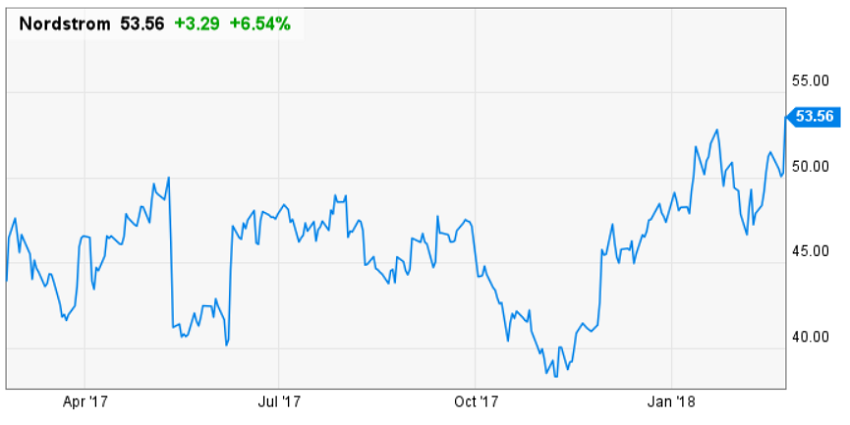 |
Chris Bell | 'The man on top of the mountain didn't fall there.' |
| - Vince Lombardi |
 |
Chris Bell | 'The man on top of the mountain didn't fall there.' |
| - Vince Lombardi |
SNHU - MBA-640 Finance, Economics & Decision Making
Written by: Chris Bell - May, 2018
As with most startup companies, new investments and expansion projects, Nordstrom will show a loss compared to the time value of their $1.5-million-dollar investment for the first 3 years. As previously mentioned, they will need to spend money traveling, hiring staff in Australia, working with the Australian government and getting comfortable conducting business in a distant location. Communications and computer systems will need to be set in place before the profits can really start coming in on a regular basis. Nordstrom isn't choosing foreign expansion randomly, but after 100 years of US growth and a successful movement into Canada. "From the internationalization process perspective, the expected sequential pattern of development is not always evident: retail companies often move directly to foreign investment; yet, knowledge transfer appears to be vital to the process (Picot-Coupey, Burt & Cliquet, 2014)." Therefore, my projections for the expansion into Australia are modest and honest in hopes to not get discouraged during the first few years.

According to Investopedia, "The time value of money (TVM) is the concept that money available at the present time is worth more than the identical sum in the future due to its potential earning capacity." Nordstrom's investment of $1.5 million dollars will therefore grow at 5.9% based on their current rate of return-on-assets, and become $2.66 million in 10 years.
My annual projections are based on average percentages from Nordstrom's financial statements over the past 3 years. For example, they tend to make twice as much revenue in comparison to the total assets, their cost of revenue averages to about 65%, their operating SGA expenses are usually 30% of revenue and their net profit ranges near 5.9% of total assets. I used most of those percentages in my formulas as I created the 10-year forecast. However, years one through three started with revenue equal to assets ($1.5 million + TVM) due to a slow but steady start, six months of construction and setup, and initial local marketing. That increases by 50% in years 2 and 3, then increases by 15% going forward. It will take 6 years to get to the 5.9% net profit margin in comparison to revenue before they can consider this expansion project as good of an investment as their current operations. The subsequent 4 years will go beyond their current net profit margins based on this investment because Australia is less congested than the United States in terms of clothing retail locations and Nordstrom locations.

Key Assumptions
Nordstrom made an extra billion dollars in revenue from 2016 to 2018 but with a smaller net profit margin. Their ratio of debt to assets is also too low because net profit is low. Their stock price seems to stay in line with their total assets, so I increased the stock price accordingly through 2021. Their revenue increased by $300,000 in 2017 and then $700,000 in 2018 and I was modest into the future because I want to focus on expenses. I love the way Nordstrom handles their cash. In 2016 through 2018 their cash balance lowers in my three favorite spots, Dividends, Purchase of Stock and Net Borrowings. Three years in a row all three were negative, an investors dream!
Conclusions
Nordstrom's expenses need to be lowered, and it needs to come from COGS or SGA in a ratio format to still focus on growth. I made one alteration which was to lower the Expenses by 2% each subsequent year. Their Liabilities are far too close to their Assets which will also be lowered by 2% each subsequent year through 2% of the net profit (noted in formulas). Nordstrom has enough people working on growth, so a team should stay focused on increasing profit margins by decreasing expenses. Even if sales don't increase, the net profit will feed straight to the net tangible assets to create some breathing room for a successful billion-dollar company. By doing one simple thing, lowering expenses by 2%, it's easy to see the balance sheet expand into more equity for the shareholders. Finally, the stock price increases based on those changes because assets increase.
Without the proposed investment project into Australia, Nordstrom's revenue has been increasing by roughly 3-4% over the past few years. If they can concentrate on lowering their expenses, especially in the SGA category, they can significantly increase their new profit margins in subsequent years, whereby snowballing the additional cash flow into continued expansion into Canada. In fact, their net profit margin could increase from 3% to 9% in 3 years if they simply cut expenses by 2% each year. Although this forecast seems attainable in hindsight, companies that focus too much on expenses rather than growth can end up in a downward spiral of firing employees, downsizing and selling assets rather than hiring new employees, creating new departments, and buying smart inventory and other assets that can fuel growth.
With the proposed investment project into Australia, Nordstrom will have a specific avenue of sending cash flow from other profitable areas of their company. Sometimes when companies expand too much into their home country stores can start to cannibalize sales from other locations. It's easier and cheaper to drop a second location in San Francisco and San Diego but it might be smarter to invest in the idea of expanding into Canada, as they have for the past decade. As they complete their expansion into Canada they will again start to look for new ideas and Australia seems like a small investment project (0.02%) for Nordstrom based on the total assets of $8 billion.
Once the initial investment is exchanged into AUD pounds Nordstrom will need to be careful before exchanging it back to USD. For example, before the US corporate tax change in 2017, the corporate tax rate was 39.6%, and according to the Australian Taxation Office at the Australian Government, they have a comparative corporate tax rate of 27.5%, which means Nordstrom would have to pay an additional 12.1% tax to bring the profits back to the US. Even though that's no longer the case in 2018, Nordstrom will need to carefully review both tax laws to capitalize the most net profits. Also, the exchange rate has varied quite a bit over the last 30 years between USD and AUD, up to 50% difference, which again, if exchanged at an inconvenient time, could hurt some of the profits gained by conducting business overseas.

In this case of such a small investment for Nordstrom, they can pull the $1.5 million from their balance sheet under cash and cash equivalents, however I'll weigh the differences as if it were bigger in relation to the size of their balance sheet.
Issuing a corporate bond and getting loan from a bank or lending institution will create an interest expense on the income statement, whereby lowering the net income of the investment project. Issuing new stock, on the other hand, will avoid an interest expense, however it will inflate the equity position of all the stock holders. For example, if there are 1 million shares available and 100,000 are issued to fund the project, each shareholder's value dropped by 10% to fund the project, similar to the government printing new money each year. It seems like a US dollar is always worth a US dollar, however when twice as many are in circulation it's worth half as much. The negative side of issuing new debt for shareholders is that the debt is guaranteed to be paid off before shareholders in the case of a crisis. Nordstrom has a strong financial history and always takes the time to not only start but also complete a successful project. "…financial resources is a multidimensional factor which includes measures that not only cover the magnitude of existing finance but incorporates also activities making firms eligible to be financed, for example the employment of appropriability mechanisms (Haapanen, Juntunen & Juntunen, 2016)." On the positive side, the shareholders have the ability to pay off the debt should the investment project prevail and cash flows increase, or even more positive and possibly riskier, they could decide to compound the new cash flow into further investment projects.
In 2018 interest rates, although increasing, are still low. A common term for corporate finance and investors is "debt is cheap" simply because most billion-dollar companies have management teams that can quickly create investment plans that return 5% or more. If they can take on debt at 2% or 3% it becomes smart to invest in those plans to make 5% or more. I would argue that taking on debt with an adjustable rate is too risky and that Nordstrom has a long history of avoiding elevated risk investments unlike technology companies. However, a fixed interest rate bond or loan near or under 4% would be a minimal risk option to fund the project. Equity financing can lead to lower dividend and stock buyback programs which is where the cash flows are intended to go, so I would vote against that option. Nordstrom has a history of slower growth when compared to other retail giants. "This slow growth strategy is the opposite of Target's Canadian approach, and only time will tell if Nordstrom's international expansion into Canada is truly successful. Sales per square foot at the Calgary store are higher than the U.S. average of $372 (US), and Nordstrom still plans to open Rack outlets in 2017 (Yoder, Visich, & Rustambekov, 2016)." Technology companies reinvest cash flows quickly to increase revenues and to increase their stock price, but if the net income and cash flows never end up on the balance sheet then the company really isn't technically worth any more than the equity, or book value, or more importantly, net tangible assets, especially when crisis hits.

The viability of Nordstrom entering various business combinations such as acquiring an existing retailer in Australia or merging with a sizable European/Australian retailer are certainly options with advantages and disadvantages to be considered. Acquiring an existing retailer would help with government regulations along with other barriers-to-entry that Nordstrom might struggle with along the way. It would also allow them to take over the existing locations and ignore their search for real estate, lease opportunities and negotiations with corporate landlords thousands of miles away. On a positive note, Nordstrom could take over a strong brand identity within Australia, make minimal changes, and plan to bring some of that brand identity back to the United States. That assumes that the retailer has positive cash flow, plans for growth and locations that fit Nordstrom's needs. However, negatively, acquiring a struggling retailer would mean Nordstrom would have to fix those problems in addition to the problems they face with the initial expand project. The negative cash flow could also be related to the location, so if Nordstrom were to acquire or merge it should only be in a positive manner rather than picking up the troubles of a struggling company.
Cotton:on Group is a major fashion retailer founded and grown in Australia with strong brand presence and $1.8 billion in annual sales. That would significantly increase this investment project, and perhaps they aren't willing to discuss a merger or acquisition, but it would provide Nordstrom with a big advantage of getting into Australia smoothly. Otherwise, Cotton:on seems as if it would be a strong competitor for Nordstrom within Australia because they've been there since 1991, they have a strong hold on their customers and their product lines are fairly similar to that of Nordstrom's. The Cotton:on management team already understands the government regulations, standard corporate environmental practices, employee satisfaction techniques, local culture and how to service their customers that are born and raised in the Australian culture and heritage.
We at Nordstrom understand that we're asking our lending partners to take a risk with $1.5 million, and to believe in Nordstrom to achieve financial success in this project to repay that debt with interest. Our balance sheet currently has $8.1 billion of assets and $7.1 billion of liabilities, and after subtracting goodwill and intangible assets, we have $739 million in net tangible assets. Out net tangible assets have increased in each of the last 5 years as we have been expanding into Canada with new locations, employees and government regulations. Our income statement shows an average of 4% revenue growth in the last 5 years and currently $15.4 billion in sales. Our net profit has average $650 billion in the last 3 years, again, during times of international expansion. With that, our cash flow statement shows positive as well, whereby giving a healthy dividend and buying back our stock based on our assessment of its intrinsic value.
Upon approval of the loan for our expansion project into Australia, we will partner together into future expansion opportunities together as we get settled into Australia. This is the riskiest time to support Nordstrom with a $1.5 million-dollar loan, and with that risk we want to give you the first opportunity to support further debt obligations throughout Australia. The entire project will be laid out in front of you as we commence and progress because we want to be transparent with the entire cost of the project. Our goal is to create a bond of trust in our relationship for future obligations.

Nordstrom offer's their employees a 401(k) plan that can willing join and Nordstrom matches a portion of the employee's contributions. Billion-dollar companies must aid to most employees when setting up these plans so they offer a few low-to-high risk options for the employees to choose from. However, as time progressed into the future and corporate companies need to have more social responsibility, Nordstrom neglected to review the options they offered, and as it turns out, only had options with very high fees. There was a class action lawsuit filed against them in November 2017 that claimed Nordstrom, a billion-dollar company with expert financial and investing expertise, was responsible for not finding lower cost options that were clearly available on the market. Even offering one low-cost index fund option could have excused Nordstrom from responsibility in this matter, however its ongoing proof that corporate companies are becoming more responsible for the livelihood of their employees with the best healthcare options, retirement savings options, bereavement for both male and female, and growth opportunities for all levels of employees that need to continue moving forward in this fast-paced world.
Aside from this legal issue, Nordstrom has a 117-year-old strong financial history of staying positive, and avoiding rapid growth opportunities compared to some competitors while still growing at a stellar average rate of $130,000,000 per year in sales to reach $15.4 billion in 2017. Nordstrom has stayed true to their home ground, culture and growth template by expanding in the US until the 113 years later that they decided to expand into Canada. Starting in 2014 they had a 3-year expansion project that was very successful into Canada, and they launched their final store within the 3-year timeline, staying on budget and on time, two difficult project successes. Not only that, their balance sheet equity and income statement net income both stayed well above positive while continuing a company-wide dividend and stock buyback program, both in the billions of dollars.
References:Australian Government (n.d.). Australian export and import laws. Retrieved from:https://www.austrade.gov.au/International/.../Australian-export-and-import-laws Karine Picot-Coupey, Steve L. Burt, Gerard Cliquet. Retailers' expansion mode choice in foreign markets: Antecedents for expansion mode choice in the light of internationalization theories Journal of Retailing and Consumer Services, Volume 21, Issue 6, 2014, pp. 976-991 Lauri Haapanen, Mari Juntunen, Jouni Juntunen. Firms' capability portfolios throughout international expansion: A latent class approach Journal of Business Research, Volume 69, Issue 12, 2016, pp. 5578-5586 Yoder, S., Visich, J. K., & Rustambekov, E. (2016). Lessons learned from international expansion failures and successes. Business Horizons, 59233-243. |